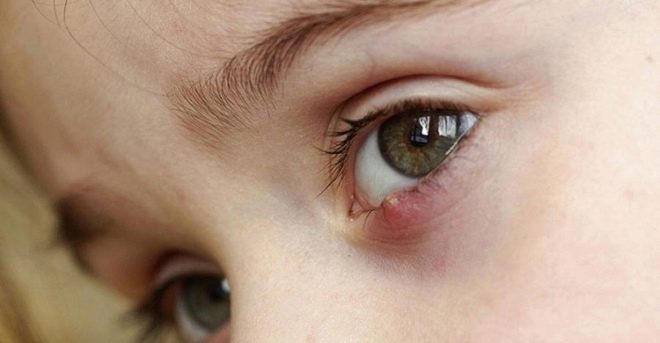Psychosomatics of barley in children and adults
Barley on the eye - an ugly and very painful condition that occurs in adults and children. Appeared abscess can cause deterioration of the general condition. Often the appearance of barley is associated with a decrease in immunity. In some people this happens very rarely, in others (more often in childhood), barley on the eye is a very frequent phenomenon.
Psychosomatic medicine has its own view on the problem, and it deserves attention at least for the reason that psychosomatics allows us to understand why some have abscesses in front of their eyes, while others have sorted out all the methods of treatment but cannot get rid of this problem.
General information
The name “barley” is a popular one, since an abscess in the eye resembles the grain of the same crop. In medicine, it has the proud Latin name "hordeolum". The disease is an inflammatory process of the eye (one or less - two), in which the disease develops due to pathogenic bacteria. An abscess does not always manifest itself, sometimes the inflammatory process is closed, internal, and only a red, painful tubercle appears on the eye.
The appearance of barley is always associated with unpleasant sensations - the affected edge of the eyelid tingles and itches, there is a feeling of local burning, swelling of the eyelid and swelling develop. Barley almost always hurts - pain is acute.
Most often the “culprit” of the appearance of gordomolum is the bacterium with a beautiful name - golden staph.. It is presented in abundance in the environment, but when it comes into contact with eyes, it begins to actively proliferate at the base of the bulbs of the ciliary hairs, as well as in the sebaceous glands of Zeiss, which leads to characteristic symptoms familiar to everyone and everyone.
Traditional medicine believes that the reason lies in the violation of hygienic requirements, when staphylococcus is entered into the eyes when rubbed or touched with dirty hands. The state of immunity also affects: if it is strong, then inflammation may not occur, because the cells of the immune system will quickly “calculate” the invader and neutralize it.
Psychosomatic causes
To understand why a child or an adult often has gordolum, you need to clearly understand what the psychosomatic meaning of the organs of vision is. The eyes are the organ that allows a person to see the outside world, to receive visual information from it, without which the idea of the world would be incomplete. That is why any diseases of visual analyzers suggest that a person does not want to see something, perceive someone or consciously “close his eyes” to himself or what is happening in the world.
Since barley is an acute inflammatory infectious disease, we can safely say that a person not only perceives with difficulty what he has to see (or another person), but also experiences strong anger, anger, irritation.
The exact location of the inflammatory element is also important: the hordeolum in the right eye says that the person is incredibly annoying in the outside world, he does not want to look at it. The appearance of barley on the left eye indicates that a person “closes his eyes”, does not want to see his own actions, his own character traits.
An abscess develops as a reaction to the subconscious command of a person “I don’t want to see it,” “I can’t look at it”: the stronger the aggression inside, the larger the barley will have and the more likely the formation of a purulent abscess. Multiple barley (several in one century) develop infrequently, but this also happens, and for a specialist in the field of psychosomatics, they say that anger and anger inside a person have accumulated for a long timebut because the exit destructive feelings found immediately through several ulcers.
Folk signs say that the appearance of barley is a sign of the "evil eye", that this is the first sign that in the near future a person will not go at all the way he would like. Of course, there is a grain of truth in this: if a person does not get rid of anger and hidden aggression, he really will not go at all what he wants, because the destructive feeling will leave an imprint not only on his health, but also on the course of his daily life .
In a child, barley has the same psychosomatic rationale as adults. But in childhood the purulent form of gordomolum is more common, which means that children often have a depressed form of aggression, anger at something and despair without the opportunity to express it in words and directly to the person who caused such sensations.
Often children suffer from eye inflammations who cannot build normal relationships in their children's team, children who grow up in families where something is happening, that the child does not just not want to look at, but he hates what is happening or his participants with all the fibers .
Opinion researchers
Louise L. Hay, a well-known author in the field of psychosomatics, argued that barley can be safely called the "disease of the evil eye". This means that a person who looks at the world, events, people through the prism of negativity, anger, aggression, jealousy, jealousy, the wishes of evil to another, often suffers from pride, than someone who tries to see good in people and treats events (even not the most pleasant) adequately.
Canadian researcher Liz Burbo writes Barley is peculiar to very impressionable and emotional people who do not have enough tact and patience to substantiate what they see and accept it.. Such people have exaggerated demands on others, do not look for compromises and are quick to punish. If someone has a different view of something, they categorically reject it, and soon face the emergence of pride.
Psychotherapist Valery Sinelnikov points to the need to see the world from a position of good and pure thoughts. If a person internally plans something evil, bad, aggressive, even if he never dares to turn it into reality, then the appearance of barley is not worth being surprised - this is an external manifestation of the internal state.
Treatment
Psychotherapists recommend people who often suffer from the appearance of barley, learn to manage your own anger and form a new, more positive view of the world and the people in it. In practice, it can be very difficult to do, especially if we are talking about adults, for whom a world view through the glass of anger has become a perennial habit and standard of living.
Such methods of psychocorrection as the formation of a critical look at yourself help a lot. If a person pronounces his own ugly actions, can talk about his own shortcomings, then he declines the requirements for others, gradually comes the understanding that others, like himself, have the right to make mistakes. Along with this, every day you need to practice the search for good in others. Think of someone who is extremely annoying to you and try to name at least five of his virtues - he is kind, responsive, an excellent specialist; he tastefully selects clothes and accessories. Advantages can be found in any person. Everyone has it. With no exceptions.
A child may need professional help from a psychologist, since it can be difficult for babies to express their negative emotions. This can be done through drawing and modeling, through the puppet theater, through the game.
Come to the aid of a wide range of techniques of art therapy. And of course, it will take a correction in family relations, so that the child can grow and develop in the most benevolent setting that he will be pleased to see.
You also need to teach your child to see the good in others: “Kohl offends you, but he is generally a very good boy, he has something to learn.”
















